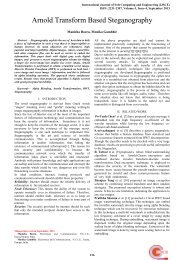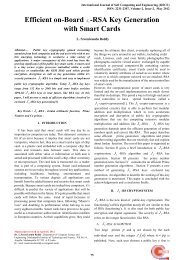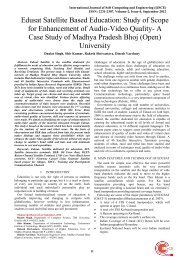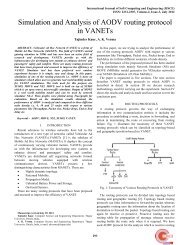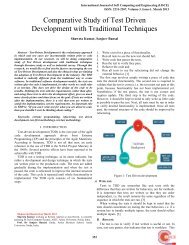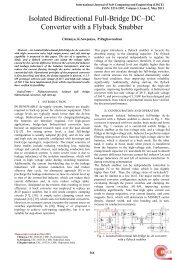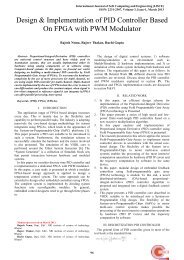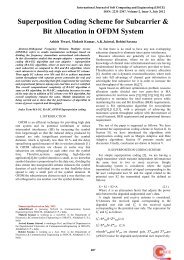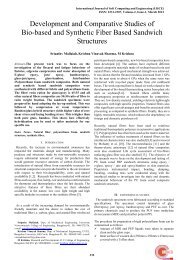Modelling of single Sided Linear Induction Motor by MATLAB ...
Modelling of single Sided Linear Induction Motor by MATLAB ...
Modelling of single Sided Linear Induction Motor by MATLAB ...
Create successful ePaper yourself
Turn your PDF publications into a flip-book with our unique Google optimized e-Paper software.
International Journal <strong>of</strong> S<strong>of</strong>t Computing and Engineering (IJSCE)<br />
ISSN: 2231-2307, Volume-2, Issue-3, July 2012<br />
<strong>Modelling</strong> <strong>of</strong> <strong>single</strong> <strong>Sided</strong> <strong>Linear</strong> <strong>Induction</strong><br />
<strong>Motor</strong> <strong>by</strong> <strong>MATLAB</strong>/SIMULINK<br />
Sijitha Issac , K.vanamathi<br />
<br />
Abstract- This paper describes a generalized model <strong>of</strong> the<br />
<strong>single</strong> sided linear induction motor and its computer simulation<br />
using <strong>MATLAB</strong>/SIMULINK. Constructional details <strong>of</strong> various<br />
sub-models for the <strong>single</strong> sided linear induction motor are given<br />
and their implementation in SIMULINK is outlined. SLIM is<br />
studied using the simulation model developed.<br />
Keywords: <strong>MATLAB</strong> modelling; simulation; SIMULINK;<br />
SLIM modelling.<br />
LIST OF SYMBOLS<br />
L s stator inductance(Primary inductance)<br />
L r rotor inductance (Secondary inductance) M mutual<br />
inductance<br />
Rs stator resistance<br />
Rr rotor resistance<br />
Rc cable resistance<br />
P pole number<br />
Vds,Vqs d-axis and q-axis components <strong>of</strong> the stator voltage<br />
vector Vs<br />
Vdr,Vqr d-axis and q-axis components <strong>of</strong> the rotor voltage<br />
vector Vr<br />
ids, iqs d-axis and q-axis components <strong>of</strong> the stator current<br />
vectors is<br />
idr,iqr d-axis and q-axis components <strong>of</strong> the rotor current<br />
vectors ir<br />
J moment <strong>of</strong> inertia <strong>of</strong> rotor<br />
I. INTRODUCTION<br />
Simulation <strong>of</strong> the <strong>single</strong> sided linear induction machine is<br />
well documented in computer hardware and s<strong>of</strong>tware, new<br />
simulation packages which are faster and more user friendly<br />
are now available. This paper discusses the use <strong>of</strong> one such<br />
product, the SIMULINK s<strong>of</strong>tware <strong>of</strong> <strong>MATLAB</strong>, in the<br />
dynamic modelling <strong>of</strong> the SLIM. The main advantage <strong>of</strong><br />
SIMULINK over other programming s<strong>of</strong>tware is that, instead<br />
<strong>of</strong> compilation <strong>of</strong> program code, the simulation model is built<br />
up systematically <strong>by</strong> means <strong>of</strong> basic function blocks. A set <strong>of</strong><br />
machine differential equations can thus be modelled <strong>by</strong><br />
interconnection <strong>of</strong> appropriate function blocks, each <strong>of</strong> which<br />
performing a specific mathematical operation. Programming<br />
efforts are drastically reduced and the debugging <strong>of</strong> errors is<br />
easy. Since SIMULINK is a model operation programmer, the<br />
simulation model can be easily developed <strong>by</strong> addition <strong>of</strong> new<br />
sub-models to cater for various control functions. As a<br />
sub-model the SLIM could be incorporated in a complete<br />
electric motor drive system.<br />
Manuscript received on July, 2012.<br />
Sijitha Issac, Electrical and Electronics Engineering, Anna University/<br />
Hindusthan college <strong>of</strong> Engineering and Technology, Coimbatore, India.<br />
K. Vanmathi, Electrical and Electronics Engineering, Anna University/<br />
Hindusthan college <strong>of</strong> Engineering and Technology, Coimbatore, India..<br />
II. SLIM MOTOR MODEL CONSTRUCTED USING<br />
SIMULINK<br />
A generalized dynamic model <strong>of</strong> the induction motor<br />
consists <strong>of</strong> an electrical sub-model to implement the<br />
three-phase to two-axis (3/2) transformation <strong>of</strong> stator voltage<br />
and current calculation, a torque sub-model to calculate the<br />
developed electromagnetic torque, and a mechanical<br />
sub-model to yield the rotor speed. In addition, a stator<br />
current output sub-model is needed for calculating the voltage<br />
drop across the supply cables.<br />
A. Electrical sub-model <strong>of</strong> the SLIM<br />
The three-phase to two-axis voltage transformation is<br />
achieved using the following equation<br />
[A]<br />
Fig.1 Electrical model <strong>of</strong> an SLIM in SIMULINK<br />
Where Vas, Vbs, and Vcs are the three-phase stator<br />
voltages, while Vds and Vqs are the two-axis components <strong>of</strong><br />
the stator voltage vector Vs.In the two-axis stator reference<br />
frame, the current equation <strong>of</strong> an induction motor can be<br />
written as<br />
As shown in Fig 1, Matrix [A] in Equation (1) and MATRIX<br />
[B] IN EQUATION (2) CAN BE IMPLEMENTED BY the „Matrix<br />
Gain‟ block <strong>of</strong> SIMULINK, while matrix [C] in Equation (2)<br />
can be implemented <strong>by</strong> four „Fcn‟ blocks <strong>of</strong> SIMULINK<br />
whose detail is illustrated in Fig. 2.In the electrical model, the<br />
three-phase voltage [Vas, Vbs, Vcs] is the input and the<br />
current vector [ids, iqs, idr, iqr] is the output vector. The rotor<br />
voltage vector is normally zero because <strong>of</strong> the short-circuited<br />
492
<strong>Modelling</strong> <strong>of</strong> <strong>single</strong> <strong>Sided</strong> <strong>Linear</strong> <strong>Induction</strong> <strong>Motor</strong> <strong>by</strong> <strong>MATLAB</strong>/SIMULINK<br />
III. SIMULATION SYSTEM OF SLIM<br />
The complete simulation system <strong>of</strong> the SLIM includes the<br />
<strong>single</strong> sided linear induction motor model in Fig 5 and a<br />
power supply sub-model.<br />
Fig.2 Matrix[c] implemented using four functional blocks <strong>of</strong><br />
SIMULINK<br />
E. Power supply sub-model<br />
The voltage supply block consists <strong>of</strong> a three-phase<br />
sinusoidal voltage generator and a terminal voltage<br />
calculation block which accounts for the voltage drop in the<br />
supply cable. The three-phase sinusoidal voltage generator is<br />
based on Equation (6) and the three phase voltages is<br />
modelled as shown in Fig. 6.<br />
cage rotor winding, i.e. Vdr=0 and Vqr=0.<br />
B. Thrust sub-model <strong>of</strong> SLIM<br />
In the two-axis stator reference frame, the thrust T is given<br />
<strong>by</strong><br />
Fig 3 shows how the thrust sub-model is realized in<br />
SIMULINK.<br />
C. Mechanical sub-model <strong>of</strong> SLIM<br />
From the thrust balance equations and neglecting viscous<br />
friction, the linear synchronous speed Vs may be obtained as<br />
follows<br />
Where |V | is the amplitude <strong>of</strong> the terminal voltage, Due to<br />
the voltage drop in the supply cable, the terminal voltage is<br />
given <strong>by</strong> Equation 7.<br />
Where J is the moment <strong>of</strong> inertia <strong>of</strong> the rotor and load and<br />
Fl is the load thrust.Fig. 4 shows the implementation <strong>of</strong> the<br />
mechanical sub-model.<br />
Fig.3 Thrust sub-model<br />
Fig.5 SLIM model in SIMULINK<br />
Fig.4 Mechanical sub-model<br />
D. Stator current output sub-model<br />
The stator current output sub-model is used to calculate the<br />
stator current amplitude according to the following<br />
equation 6.<br />
A SIMULINK function block is used to implement<br />
the above equation. The electrical sub-model in Fig. 1, the<br />
thrust sub-model in Fig. 3, the mechanical sub-model in Fig.<br />
4, and the stator current output sub-model are grouped<br />
together to form the SLIM model as shown in Fig 5.<br />
Fig 6 <strong>Modelling</strong> supply phase in SIMULINK<br />
Where E is the supply voltage and Rc is the cable<br />
resistance. Fig. 7 shows how the equation is modelled in<br />
SIMULINK. Grouping the voltage generator block <strong>of</strong> Fig. 6<br />
and terminal-voltage calculation block <strong>of</strong> Fig. 7, the power<br />
supply block is formed as shown in Fig. 8.<br />
E. Simulation model <strong>of</strong> SLIM<br />
The SLIM model in Fig. 5 and the power supply sub-model<br />
in Fig. 8 are grouped together to form the complete induction<br />
motor simulation model as shown in Fig. 9. The XY-graph is<br />
used to display the dynamic thrust/linear synchronous speed<br />
493
characteristic <strong>of</strong> the SLIM, while the scope block enables the<br />
speed, stator current, and stator voltage <strong>of</strong> the motor to be<br />
observed.<br />
International Journal <strong>of</strong> S<strong>of</strong>t Computing and Engineering (IJSCE)<br />
ISSN: 2231-2307, Volume-2, Issue-3, July 2012<br />
Fig.7 Terminal-voltage calculation block<br />
Fig.11 Simulation results<br />
Fig.8 Power supply block<br />
Fig.9 Simulation system <strong>of</strong> an SLIM in SIMULINK<br />
IV. SIMULATION RESULTS<br />
The SLIM chosen for the simulation studies has the<br />
following specifications.<br />
Three-phase, 2.1 KVA,415V, 2-pole,short primary<br />
stator,length <strong>of</strong> stator(max) 300mm,Length <strong>of</strong> reaction plate<br />
4m(max), maximum current turns per active slot<br />
1000AT/inch2,maximum running time 10mints,rated slip<br />
5-10%<br />
Rs=0.288 V/ph Rr=0.158 V/ph<br />
L s=0.0425 V/ph L m=0.0412 V/ph<br />
L r=0.0418 V/ph J=0.4 kg m2<br />
Fig. 10 and Fig.11 show the results <strong>of</strong> computer simulation<br />
using the SIMULINK model.<br />
V. CONCLUSION<br />
SIMULINK is a powerful s<strong>of</strong>tware package for the study<br />
<strong>of</strong> dynamic SLIM. Using SIMULINK, the simulation model<br />
can be built up systematically starting from simple<br />
sub-models.<br />
VI. REFERENCES<br />
[1] R.M Pai, Ion Boldea “ A complete equivalent circuit <strong>of</strong> a linear<br />
induction motor with sheet secondary”IEEE Trantransactions on<br />
magnetics, 24,No.1 ,pp 639-654 ,1988.<br />
[2] George H Abdou and Sherif A sheriff, “Theoretical and experimental<br />
design <strong>of</strong> LIM in automated manufacturing systems”IEEE<br />
Transactions on industry applications,vol 27,N0.2,1991.<br />
[3] [N Sadow Ski, Y.Lefevre, M.Lajoie-Mazone J;Cros, “Finite element<br />
torque calculation in electrical machines while considering the<br />
movement” IEEE Trantransactions on magnetics, 28,No.2 ,pp<br />
1410-1413,1992.<br />
[4] V.V Vadher and I.R Smith,“Performance <strong>of</strong> segmented rotor tubular<br />
linear induction motor” IEEE Trantransactions on magnetics, 29,No.6<br />
,pp 2941-2943,1993.<br />
[5] G.E Adams “Tubular linear induction motor for hydraulic capsule<br />
pipeline-finite element analysis” IEEE Transactions on Energy<br />
conversion, Vol.8,No.2, pp. 251-256,1993.<br />
[6] Jorge Freitas,Jorge Dias,Avelar Freitas,Carlos Cabrita “Optimized<br />
design <strong>of</strong> the tubular induction actuator aided <strong>by</strong><br />
computer”,IEEE,1994,PP 770-772<br />
[7] Atencia J,Rico,A Garcia, Florez.J(2001) “A low cost linear induction<br />
motor for laboratary experiments”International journal<strong>of</strong> EEE pp<br />
118-134<br />
Fig.10 Thrust/linear synchronous speed characteristics<br />
494



